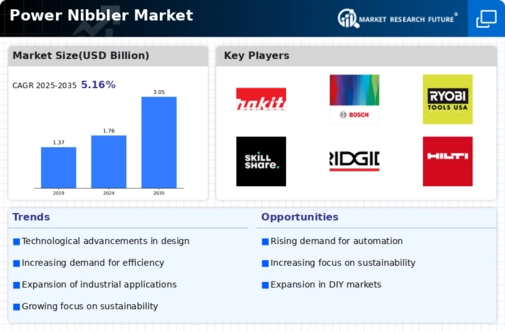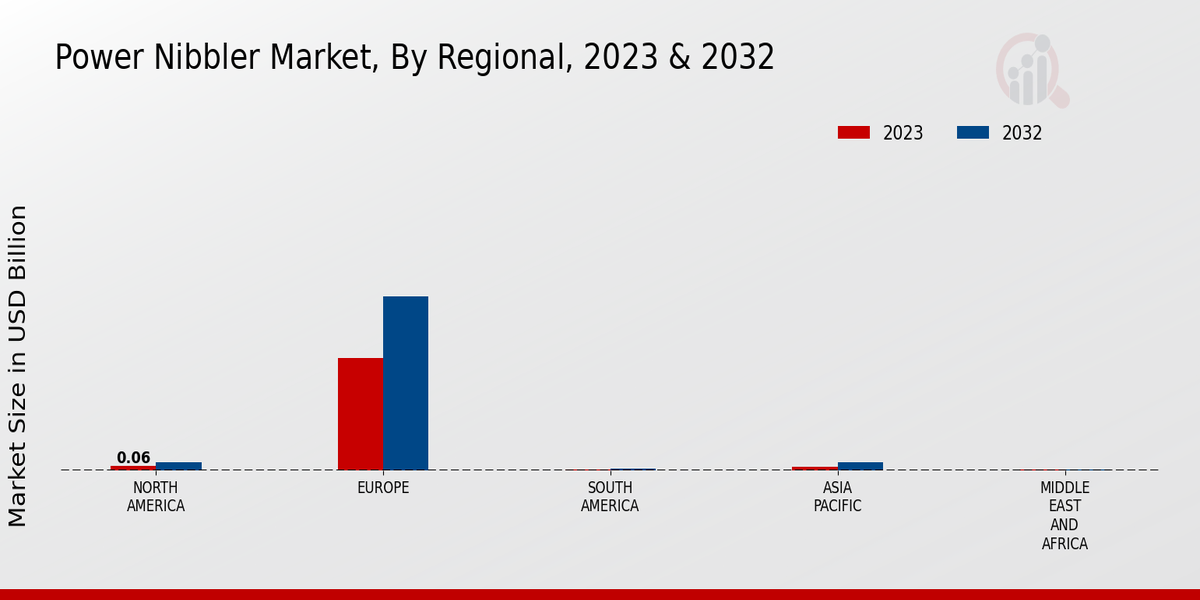Market Growth Projections
The Global Power Nibbler Market Industry is projected to experience substantial growth over the next decade. With a market value of 1.76 USD Billion in 2024, it is anticipated to reach 3.05 USD Billion by 2035, reflecting a compound annual growth rate (CAGR) of 5.12% from 2025 to 2035. This growth trajectory indicates a robust demand for power nibblers across various sectors, driven by technological advancements, increased construction activities, and a rising focus on safety standards. The market's expansion is likely to create new opportunities for manufacturers and suppliers, positioning power nibblers as essential tools in modern industrial applications.
Growth in Construction Activities
The Global Power Nibbler Market Industry is significantly influenced by the growth in construction activities worldwide. As urbanization accelerates, the demand for efficient construction tools rises, leading to increased adoption of power nibblers. These tools are essential for cutting through various materials, including metal sheets and panels, which are commonly used in construction projects. The expansion of infrastructure and residential projects globally is expected to drive the market's growth. This trend is particularly evident in emerging economies, where construction activities are booming, thereby enhancing the market potential for power nibblers.
Increased Focus on Safety Standards
The Global Power Nibbler Market Industry is also benefiting from an increased focus on safety standards in manufacturing and construction environments. As industries prioritize worker safety, the demand for tools that minimize risks associated with cutting operations is rising. Power nibblers, designed with safety features such as blade guards and ergonomic handles, are becoming preferred choices for operators. This shift towards safer tools is likely to enhance market growth, as companies seek to comply with stringent safety regulations. The emphasis on safety not only protects workers but also reduces liability for businesses, making power nibblers a strategic investment.
Rising Demand for Lightweight Materials
The Global Power Nibbler Market Industry is witnessing a surge in demand for lightweight materials, particularly in the automotive and aerospace sectors. As manufacturers increasingly adopt aluminum and composite materials for their products, the need for efficient cutting tools like power nibblers becomes paramount. These tools facilitate precise cuts without compromising the integrity of the materials. This trend is expected to contribute significantly to the market's growth, with projections indicating a market value of 1.76 USD Billion in 2024. The shift towards lightweight materials aligns with global sustainability goals, further driving the adoption of power nibblers.
Technological Advancements in Cutting Tools
Technological advancements are playing a crucial role in shaping the Global Power Nibbler Market Industry. Innovations in battery technology, such as lithium-ion batteries, enhance the performance and efficiency of power nibblers, making them more appealing to users. Additionally, the integration of smart technology allows for improved precision and control during operation. These advancements not only increase productivity but also reduce operational costs for businesses. As a result, the market is projected to grow at a CAGR of 5.12% from 2025 to 2035, reaching an estimated value of 3.05 USD Billion by 2035, indicating a robust future for power nibblers.
Expansion of DIY and Home Improvement Trends
The Global Power Nibbler Market Industry is experiencing growth due to the expansion of DIY and home improvement trends. As more individuals engage in home renovation projects, the demand for versatile and user-friendly tools like power nibblers is increasing. These tools allow homeowners to perform precise cuts on various materials, making them ideal for DIY enthusiasts. The rise in online tutorials and home improvement shows further fuels this trend, encouraging consumers to invest in quality tools. Consequently, the market is likely to see a steady increase in demand, reflecting the changing dynamics of consumer behavior in the home improvement sector.

























Leave a Comment